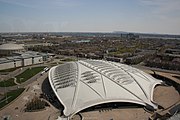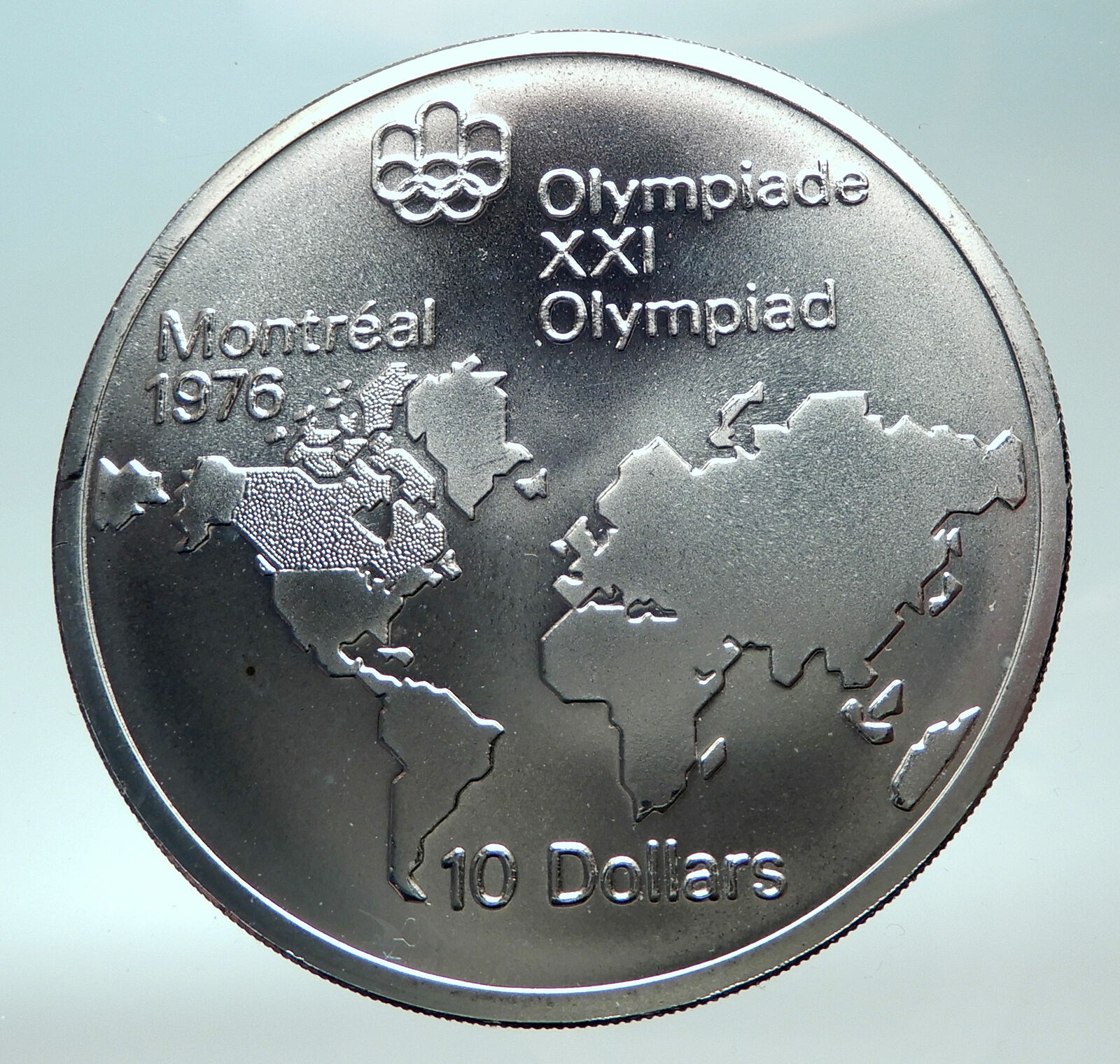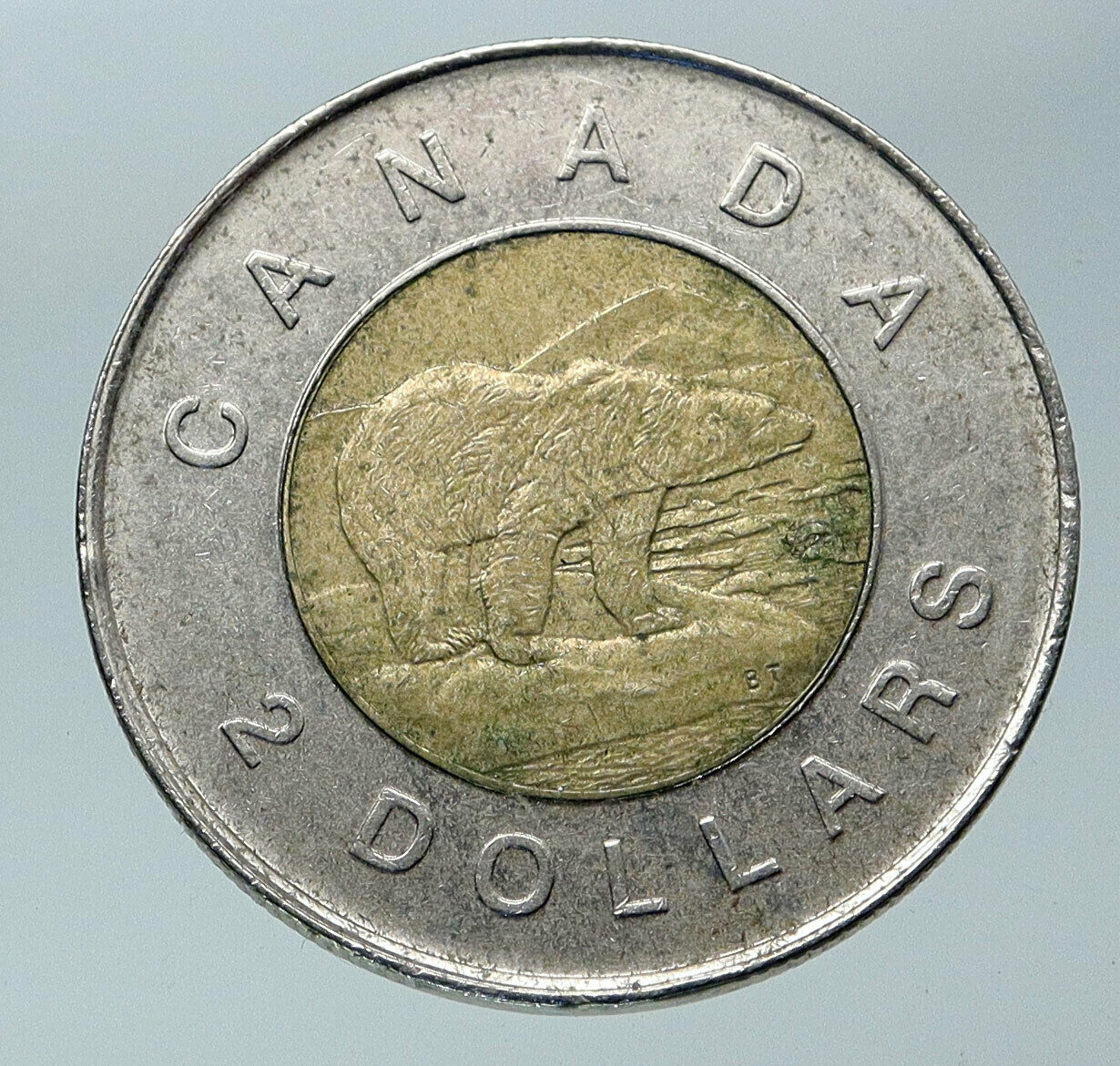|
Canada – Montreal Summer Olympics 1976 Commemorative Issue
1976 Silver 10 Dollars 45mm (48.60 grams) 0.925 Silver (1.4453 oz. ASW)
Reference: KM# 114
ELIZABETH II CANADA 1976, Elizabeth II portrait.
OLYMPIADE XXI OLYMPIAD MONTREAL 1976 10 DOLLARS, Olympic Velodrome.
You are bidding on the exact item pictured, provided with a Certificate of Authenticity and Lifetime Guarantee of Authenticity.
A velodrome is an arena for track cycling. Modern velodromes feature steeply banked oval tracks, consisting of two 180-degree circular bends connected by two straights. The straights transition to the circular turn through a moderate easement curve.
 The Montreal Biodome (French: Biodôme de Montréal) is a facility located at Olympic Park in the Mercier-Hochelaga-Maisonneuve neighbourhood of Montreal, Quebec, Canada, that allows visitors to walk through replicas of four ecosystems found in the Americas. The building was originally constructed for the 1976 Olympic Games as a velodrome. It hosted both track cycling and judo events. Renovations on the building began in 1989 and in 1992 the indoor nature exhibit was opened. The Montreal Biodome (French: Biodôme de Montréal) is a facility located at Olympic Park in the Mercier-Hochelaga-Maisonneuve neighbourhood of Montreal, Quebec, Canada, that allows visitors to walk through replicas of four ecosystems found in the Americas. The building was originally constructed for the 1976 Olympic Games as a velodrome. It hosted both track cycling and judo events. Renovations on the building began in 1989 and in 1992 the indoor nature exhibit was opened.
The Montreal Biodome is one of four facilities that make part of the largest natural science museum complex in Canada, Space for Life, which also includes the Montreal Insectarium, Montreal Botanical Garden, and Rio Tinto Alcan Planetarium. It is an accredited member of both the Association of Zoos and Aquariums (AZA) and the Canada’s Accredited Zoos and Aquariums association (CAZA).
History
The building was designed by French architect Roger Taillibert as part of his larger plan for an Olympic park that included the Montreal Olympic Stadium and the Olympic pool. The venue was a combined velodrome and judo facility. Construction of the building began in August 1973, and the facility was officially opened in April 1976.
The velodrome, along with the accompanying Olympic pool, inspired Tallibert’s later designs for Luxembourg’s National Sports and Culture Centre.
In 1988, a feasibility study was conducted for converting the velodrome into a biodome. Construction started in 1989, and the facility was opened to the public on 18 June 1992 as the Montreal Biodome.
In the summer of 2003, the Biodome installed an audio guide system that lets visitors get information about what they are viewing, and also provides statistics to the facility about what the visitors find most interesting. Visitors can rent a receiver programmed to receive French, Spanish, or English for adults, or French or English for children.
Exhibits
The facility allows visitors to walk through replicas of four ecosystems found in the Americas:
- The Tropical Forest is a replica of the South American rainforest.
- The Laurentian Forest is a replica of the North American wilderness.
- The Saint Lawrence Marine Eco-system is an estuary habitat modelled on the Gulf of Saint Lawrence.
- The Sub-Polar Region is a habitat that is divided into Arctic and Antarctic.
All the exhibits are housed inside the former velodrome (cycling stadium) that was used for the cycling and judo events of the 1976 Summer Olympics, with each of the four environments taking up a portion of the stadium. A variety of animals live in each simulated habitat, ranging from the macaws in the Tropical Forest, to the lynx in the Laurentian Forest, to the penguins in the Antarctic and the different kinds of fish that inhabit the waters of the Saint Lawrence River. As well, two new species have been discovered living in the Biodome: the acarian Copidognathus biodomus in the simulated estuary in 1996, and the bacterium Nitratireductor aquibiodomus in the water reprocessing system in 2003.
 The 1976 Summer Olympics, officially called the Games of the XXI Olympiad (French: Les XXIes olympiques d’été), was an international multi-sport event in Montreal, Quebec, in 1976, and the first Olympic Games held in Canada. The 1976 Summer Olympics, officially called the Games of the XXI Olympiad (French: Les XXIes olympiques d’été), was an international multi-sport event in Montreal, Quebec, in 1976, and the first Olympic Games held in Canada.
Montreal was awarded the rights to the 1976 Games on May 12, 1970, at the 69th IOC Session in Amsterdam, over the bids of Moscow and Los Angeles. It was the first and, so far, only Summer Olympic Games to be held in Canada. Calgary and Vancouver later hosted the Winter Olympic Games in 1988 and 2010, respectively.
Twenty-nine countries, mostly African, boycotted the Montreal Games when the International Olympic Committee (IOC) refused to ban New Zealand, after the New Zealand national rugby union team had toured South Africa earlier in 1976 in defiance of the United Nations’ calls for a sporting embargo.
Host city selection
The vote occurred on May 12, 1970, at the 69th IOC Session in Amsterdam, Netherlands. While Los Angeles and Moscow were viewed as the favourites given that they represented the world’s two main powers, many of the smaller countries supported Montreal as an underdog and as a relatively neutral site for the games. Los Angeles was eliminated after the first round and Montreal won in the second round. Moscow would go on to host the 1980 Summer Olympics and Los Angeles the 1984 Summer Olympics. One blank vote was cast in the second and final round.
Toronto had made its third attempt for the Olympics but failed to get the support of the Canadian Olympic Committee, which selected Montreal instead.
Organization
Robert Bourassa, then the Premier of Quebec, first asked Prime Minister Pierre Trudeau to advise Canada’s monarch, Elizabeth II, to attend the opening of the games. However, Bourassa later became unsettled about how unpopular the move might be with sovereigntists in the province, annoying Trudeau, who had already made arrangements. The leader of the Parti Québécois at the time, René Lévesque, sent his own letter to Buckingham Palace, asking the Queen to refuse her prime minister’s request, though she did not oblige Lévesque as he was out of his jurisdiction in offering advice to the Sovereign.
In 1976, Trudeau, succumbing to pressure from the Communist Chinese, issued an order barring Taiwan from participating as China in the 1976 Montreal Olympics, although technically it was a matter for the IOC. His action strained relations with the United States – from President Ford, future President Carter and the press.
Cost and cost overrun
The Oxford Olympics Study estimates the outturn cost of the Montreal 1976 Summer Olympics at USD 6.1 billion in 2015-dollars and cost overrun at 720% in real terms. This includes sports-related costs only, that is, (i) operational costs incurred by the organizing committee for the purpose of staging the Games, e.g., expenditures for technology, transportation, workforce, administration, security, catering, ceremonies, and medical services, and (ii) direct capital costs incurred by the host city and country or private investors to build, e.g., the competition venues, the Olympic village, international broadcast center, and media and press center, which are required to host the Games. Indirect capital costs are not included, such as for road, rail, or airport infrastructure, or for hotel upgrades or other business investment incurred in preparation for the Games but not directly related to staging the Games. The cost overrun for Montreal 1976 is the highest cost overrun on record for any Olympics. The cost and cost overrun for Montreal 1976 compares with costs of USD 4.6 billion and a cost overrun of 51% for Rio 2016 and USD 15 billion and 76% for London 2012. Average cost for the Summer Games from 1960 to 2016 is 5.2 billion 2015 US dollars, average cost overrun is 176%.
Much of the cost overruns were caused by the Conseil des métiers de la construction union whose leader was André “Dede” Desjardins, and who kept the construction site in “anarchic disorder” as part of a shakedown. The French architect Roger Taillibert who designed the Olympic stadium recounted in his 2000 book Notre Cher Stade Olympique that he and Montreal mayor Jean Drapeau tried hard to buy off Desjardins, even taking him to a lunch at the exclusive Ritz-Carlton hotel in a vain attempt to end the “delays”. Ultimately Quebec Premier Robert Bourassa made some sort of secret deal to buy off Desjardins, which finally allowed work to proceed. Taillibert wrote in Notre Cher Stade Olympique “If the Olympic Games took place, it was thanks to Dede Desjardins. What irony!”
.svg/220px-Canada_(orthographic_projection).svg.png)  Canada is a country, consisting of ten provinces and three territories, in the northern part of the continent of North America. It extends from the Atlantic to the Pacific and northward into the Arctic Ocean, covering 9.98 million square kilometres (3.85 million square miles) in total, making it the world’s second-largest country by total area and the fourth-largest country by land area. Canada’s common border with the United States forms the world’s longest land border. Canada is sparsely populated overall, the majority of its land territory being dominated by forest and tundra as well as the mountain range of the Rocky Mountains; about four-fifths of the population live near to the southern border. The majority of Canada has a cold or severely cold winter climate, but southerly areas are warm in summer. Canada is a country, consisting of ten provinces and three territories, in the northern part of the continent of North America. It extends from the Atlantic to the Pacific and northward into the Arctic Ocean, covering 9.98 million square kilometres (3.85 million square miles) in total, making it the world’s second-largest country by total area and the fourth-largest country by land area. Canada’s common border with the United States forms the world’s longest land border. Canada is sparsely populated overall, the majority of its land territory being dominated by forest and tundra as well as the mountain range of the Rocky Mountains; about four-fifths of the population live near to the southern border. The majority of Canada has a cold or severely cold winter climate, but southerly areas are warm in summer.
The land now called Canada has been inhabited for millennia by various Aboriginal peoples. Beginning in the late 15th century, British and French colonies were established on the region’s Atlantic coast. As a consequence of various conflicts, the United Kingdom gained and lost North American territories until left, in the late 18th century, with what mostly comprises Canada today. Pursuant to the British North America Act, on July 1, 1867, three colonies joined to form the autonomous federal Dominion of Canada. This began an accretion of provinces and territories to the new self-governing Dominion. In 1931, Britain granted Canada near total independence with the Statute of Westminster 1931 and full sovereignty was attained when the Canada Act 1982 severed the vestiges of legal dependence on the British parliament.
Canada is a federal parliamentary democracy and a constitutional monarchy, Queen Elizabeth II being the current head of state. The country is officially bilingual at the federal level. It is one of the world’s most ethnically diverse and multicultural nations, the product of large-scale immigration from many countries, with a population of approximately 35 million as of 2015. Its advanced economy is the eleventh largest in the world, relying chiefly upon its abundant natural resources and well-developed international trade networks. Canada’s long and complex relationship with the United States has had a significant impact on its economy and culture.
Canada is a developed country and one of the wealthiest in the world, with the tenth highest nominal per capita income globally, and the eighth highest ranking in the Human Development Index. It ranks among the highest in international measurements of government transparency, civil liberties, quality of life, economic freedom, and education. Canada is a Commonwealth Realm member of the Commonwealth of Nations, a member of the Francophonie, and part of several major international and intergovernmental institutions or groupings including the North Atlantic Treaty Organization, the G8, the Group of Ten, the G20, the North American Free Trade Agreement and the Asia-Pacific Economic Cooperation forum.
|






 The Montreal Biodome (French: Biodôme de Montréal) is a facility located at Olympic Park in the Mercier-Hochelaga-Maisonneuve neighbourhood of Montreal, Quebec, Canada, that allows visitors to walk through replicas of four ecosystems found in the Americas. The building was originally constructed for the 1976 Olympic Games as a velodrome. It hosted both track cycling and judo events. Renovations on the building began in 1989 and in 1992 the indoor nature exhibit was opened.
The Montreal Biodome (French: Biodôme de Montréal) is a facility located at Olympic Park in the Mercier-Hochelaga-Maisonneuve neighbourhood of Montreal, Quebec, Canada, that allows visitors to walk through replicas of four ecosystems found in the Americas. The building was originally constructed for the 1976 Olympic Games as a velodrome. It hosted both track cycling and judo events. Renovations on the building began in 1989 and in 1992 the indoor nature exhibit was opened.  The 1976 Summer Olympics, officially called the Games of the XXI Olympiad (French: Les XXIes olympiques d’été), was an international multi-sport event in Montreal, Quebec, in 1976, and the first Olympic Games held in Canada.
The 1976 Summer Olympics, officially called the Games of the XXI Olympiad (French: Les XXIes olympiques d’été), was an international multi-sport event in Montreal, Quebec, in 1976, and the first Olympic Games held in Canada. .svg/220px-Canada_(orthographic_projection).svg.png)
 Canada is a country, consisting of ten provinces and three territories, in the northern part of the continent of North America. It extends from the Atlantic to the Pacific and northward into the Arctic Ocean, covering 9.98 million square kilometres (3.85 million square miles) in total, making it the world’s second-largest country by total area and the fourth-largest country by land area. Canada’s common border with the United States forms the world’s longest land border. Canada is sparsely populated overall, the majority of its land territory being dominated by forest and tundra as well as the mountain range of the Rocky Mountains; about four-fifths of the population live near to the southern border. The majority of Canada has a cold or severely cold winter climate, but southerly areas are warm in summer.
Canada is a country, consisting of ten provinces and three territories, in the northern part of the continent of North America. It extends from the Atlantic to the Pacific and northward into the Arctic Ocean, covering 9.98 million square kilometres (3.85 million square miles) in total, making it the world’s second-largest country by total area and the fourth-largest country by land area. Canada’s common border with the United States forms the world’s longest land border. Canada is sparsely populated overall, the majority of its land territory being dominated by forest and tundra as well as the mountain range of the Rocky Mountains; about four-fifths of the population live near to the southern border. The majority of Canada has a cold or severely cold winter climate, but southerly areas are warm in summer.




